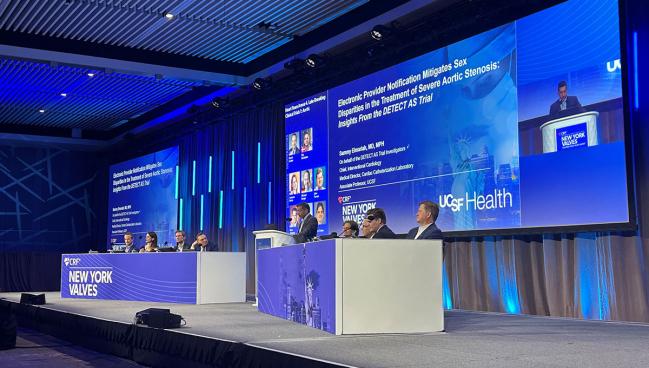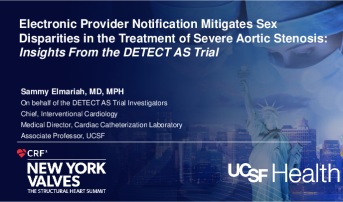Alerts to Physicians Close Gaps in AS Management Between Women, Men
In DETECT AS, the passive notifications improved rates of AVR and boosted survival, with bigger gains in women.

NEW YORK, NY—Providing electronic alerts about the management of severe aortic stenosis to physicians has greater benefits for female versus male patients, an analysis of the DETECT AS trial affirms.
EPN, which alerts physicians to the presence of severe aortic stenosis and provides patient-specific guideline recommendations for management, “serves as a simple, scalable tool to improve the quality of care for aortic stenosis and to combat disparities in the delivery of AVR,” he said.
The lead discussant for the study, Suzanne Baron, MD (Massachusetts General Hospital, Boston, MA), called DETECT AS “an important trial” that evaluated “a very straightforward, very approachable way of how can we actually treat our patients.”
“And more importantly,” she continued, “you’ve also shown that this treatment can help address some of the known disparities that we see, both in women as well as hopefully, potentially, in underrepresented minorities.”
Impact of Sex in DETECT AS
Aortic stenosis “remains markedly undertreated,” said Elmariah, adding that “this notably occurs amongst women, who are disproportionately exposed to the adverse consequences of untreated aortic stenosis or delayed aortic valve replacement.”
To explore whether EPN could help reduce those disparities, researchers performed a secondary analysis of DETECT AS, a pragmatic, single-blinded, cluster-randomized trial conducted within the Massachusetts General Hospital academic health system. The study included 285 providers caring for 945 patients (mean age 77 years; 47% women) who had a transthoracic echocardiogram (TTE) revealing an aortic valve area ≤ 1.0 cm2 (mean 0.8 cm2). The providers were randomized to receive electronic alerts for each of their patients or to continue with usual care.
Men were more likely to have undergone cardiac surgery and to have reduced LVEF, whereas women were more likely to have been evaluated by a valve specialist and to have low-gradient aortic stenosis.
The main results of the DETECT AS trial, reported earlier this year, showed that EPN improved the proportion of patients who underwent AVR within 1 year of the index TTE (47.8% vs 37.6%; HR 1.37; 95% CI 1.02-1.84), with a subgroup analysis suggesting a greater response in women versus men.
The secondary analysis delved deeper into the sex differences, confirming that women had more to gain from implementing EPN. Compared with usual care, the intervention significantly boosted the proportion of women who underwent AVR within a year (46.8% vs 25.9%; OR 2.78; 95% CI 1.69-4.57), with no significant impact in men (49.8% vs 45.5%; OR 1.16; 95% CI 0.73-1.83). Among patients treated by physicians who received EPN, there was no difference in rates of AVR between women and men (HR 0.90; 95% CI 0.70-1.16), but women lagged behind men in the usual-care arm (HR 0.46; 95% CI 0.35-0.62).
The findings were consistent in the subset of patients who were symptomatic and would thus meet guideline criteria for clinical intervention. Use of EPN remained a predictor of AVR among women even after adjustment for baseline imbalances (HR 1.92; 95% CI 1.27-2.70).
Women also saw a greater boost in restricted mean survival time during 1 year of follow-up, particularly in the symptomatic subset—26 days for women and 17 days for men. Moreover, implementation of EPN resulted in both sexes being similarly apt to receive a diagnosis of aortic stenosis.
Compared with usual care, the intervention increased the proportion of patients who received a specialist referral for aortic stenosis for both women (45% vs 30%; P < 0.05) and men (47% vs 39%; P < 0.01), with no differences by sex when notifications were used.
Next Steps
Baron asked Elmariah if there were plans to look into whether EPN can help eliminate other disparities in the management of aortic stenosis, such as those present for patients from underrepresented minority groups.
DETECT AS was underpowered to address that question, but Elmariah said there is an ongoing observational analysis across the University of California system that aims to get at that question.
As for what to look out for when rolling out an EPN intervention in other health systems, Elmariah underscored that it does represent a culture shift and may meet resistance. He also alluded to the need to modify the approach to ensure that all patients are getting the attention they require.
“The next step as we think about this is really to make it more than just a passive notification, which is what the electronic provider notifications were in DETECT AS,” he said. “There are still clearly patients that fall through the cracks. Even with notifications in the symptomatic arm, you see . . . that there’re still arguably 40% of patients that are not receiving treatment.”
What his team is working on now, he said, is “facilitated referral for aortic valve replacement,” which would give physicians an easy way to accept or deny the request for a referral and—if a notification is ignored—provide an automatic referral to ensure patients get some level of specialty care.
Todd Neale is the Associate News Editor for TCTMD and a Senior Medical Journalist. He got his start in journalism at …
Read Full BioSources
Elmariah S. Electronic provider notification mitigates sex disparities in the treatment of severe aortic stenosis: insights from the DETECT AS trial. Presented at: New York Valves 2025. June 25, 2025. New York, NY.
Disclosures
- DETECT AS was sponsored by Edwards Lifesciences.
- Elmariah reports grant/research support from Abbott, Edwards Lifesciences, and Medtronic; consulting fees/honoraria from Edwards Lifesciences; and an executive role for and ownership interest in Prospect Health.





Comments